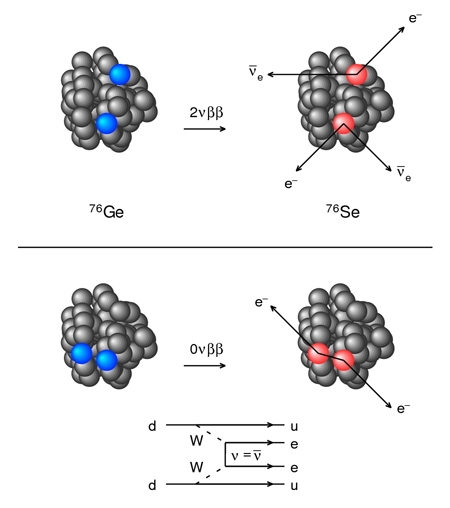New Insight Into Neutrinoless Double Beta Decay
by Alex Brown
A research project in collaboration with Mihai Horoi's group at Central Michigan is on the nuclear structure theory required for understanding double-beta decay. Many properties of the active neutrinos are measured by the fact that they are observed to oscillate, i.e, transform during their flight from an electron-type neutrino to a muon-type neutrino or/and a tau-type neutrino. But it is not yet established whether they are Dirac or Majorana type particles and their absolute masses are not known. Left-right symmetric extensions to the standard model provide an explanation for the non-zero masses of the left-handed light neutrinos and also predict the existence of right-handed heavy neutrinos. The search is now on for the special type of double-beta decay where no neutrinos are emitted (neutrinoless). If this decay process is observed these experiments will determine that the neutrino is a Majorana type fermion and it could also be used to determine the absolute mass scale (a Majorana fermion is one that is identical to its anti-particle). Over the next decade several large-scale experiments are planned that will be sensitive to a neutrino mass scale below about 0.1 eV.
The decay rate for neutrinoless double-beta decay is proportional the the square of a nuclear matrix element, and this must be calculated in order to extract the neutrino mass. This is where nuclear theory comes in. At present, several different types of structure models have been applied, and they give results that differ by factors of up to 2 to 3. Our goal is to find the reason for this difference and to make more accurate calculations, so that the best type of experiment can be planned and interpreted.
We have recently found a new way to understand the structure dependence of these matrix elements by "expanding" them in terms of the contributions from states in the nucleus with two less nucleons, i.e, 74Ge in the case of 76Ge decay. We find that the expansion is dominated by the ground state of this nucleus and that the operator is similar to that for the Coulomb interaction [1]. With this expansion obe can make connections with the well established nuclear pairing interaction, to the nuclear masses [2], and to the correlations observed in the two-nucleon transfer and two-nucleon knockout experiments between nuclei that differ by two nucleons. In the end everything is connected.

The figure shows the two type of double beta decay for 76Ge. The top is the standard mode of decay where two electons and two neutrinos are emitted. Below that is the new mode of neutrinoless decay where only the two electrons are emitted. The bottom shows the Feynman diagram in terms of the fundamental electroweak interaction with quarks.
References
[1] B. A. Brown, M. Horoi and R. A. Sen'kov, Phys. Rev. Lett. 113, 262501 (2014). link to paper
[2] B. A. Brown, Phys. Rev. Lett. 111, 162502 (2013). link to paper



